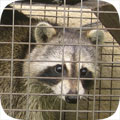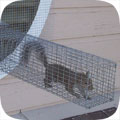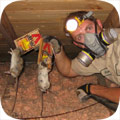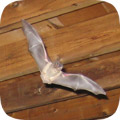- stgeorge@wildlifeanimalcontrol.com
Call 24/7 for a free quote:
435-238-4149
St George Wildlife Animal Control
Professional Wildlife Removal Company Servicing St George, UT
If you have a problem with wildlife in your St George home, your best option is to hire a company that specializes in Utah wildlife removal only. This is a specialty business, and regular pest control companies do not use the proper techniques to solve animal problems. I have spent many years reviewing Utah and St George, and I recommend the following:
Pro Wildlife Removal St George
Cell Phone: 435-238-4149
NOTE: If you have a dog or cat problem, call Washington County Animal Services: (435) 627-4350

Pro Wildlife Removal St George specializes primarily in removing animals from attics of homes and buildings - this includes squirrels in attics, raccoons, and rats or mice in homes. Utah also has a documented problem with
bats in buildings, and Pro Wildlife Removal St George is specially trained in bat removal. They also perform general wildlife trapping services, such as the capture and removal of skunks or opossums on the
property. Call 435-238-4149 to discuss your critter problem and schedule a same-day or next-day appointment. Click here to learn more about what prices we charge in 2023.
When hiring a company to solve your wild animal problem, you want these features:
- Specializes in wildlife removal, not pest control
- Fully Utah and Washington County licensed and insured
- Works 7 days per week (critters don't take weekends off)
- Performs full building inspections: enters and inspects attic
- Performs exclusion repairs, with guarantee against animal re-entry
- Offers cleanup of biohazardous wildlife waste
Pro Wildlife Removal St George is a full-service St George wildlife removal company. This is very different from a regular St George pest control company. The pest control companies spray poison to kill insects. This is not at all
similar to wildlife removal. Pro Wildlife Removal St George performs a full inspection of the home or property, and determines why the animal(s) are there, and if inside a building, how the animals got inside. All
animals (including rodents) are trapped and removed, or if possible, removed from the building using special exclusion devices. Once the animals are gone, preventative repairs are essential, and
cleanup is sometimes recommended.
 St George wildlife trapping - it's not as simple as it may seem. It's illegal in Utah to trap without a license. Trap type is very important and there are many different types, bait is somewhat relevant, trap placement
is vital, and there are dozens of small things that are very important to know.
Safety is a concern. Then once the animal is trapped, it must be removed and dealt with in the proper manner according to Utah law. We offer St George raccoon removal. Read more about how to get rid of raccoons.
St George wildlife trapping - it's not as simple as it may seem. It's illegal in Utah to trap without a license. Trap type is very important and there are many different types, bait is somewhat relevant, trap placement
is vital, and there are dozens of small things that are very important to know.
Safety is a concern. Then once the animal is trapped, it must be removed and dealt with in the proper manner according to Utah law. We offer St George raccoon removal. Read more about how to get rid of raccoons.
 Animals in attics - this is our specialty at Pro Wildlife Removal St George. Many types of animals like to live in attics. This includes squirrels, raccoons, rats, mice, bats, birds, and even possums. Critters like to go into attics for a safe place to live
and raise their young. Removing animals from attics is very complex work, partly because of the presence of baby animals. If you need St George squirrel removal, we can remove all the squirrels from your attic, and seal out any future ones. Read more about how to get rid of squirrels.
Animals in attics - this is our specialty at Pro Wildlife Removal St George. Many types of animals like to live in attics. This includes squirrels, raccoons, rats, mice, bats, birds, and even possums. Critters like to go into attics for a safe place to live
and raise their young. Removing animals from attics is very complex work, partly because of the presence of baby animals. If you need St George squirrel removal, we can remove all the squirrels from your attic, and seal out any future ones. Read more about how to get rid of squirrels.
 Rodent control must be done in a very specific way. First off, the most important thing is that all the openings that rats and mice can use to enter a house be sealed. Then all the rodents must be physically trapped and removed.
Never, ever use poison! Most St George exterminators will just use this lazy poison technique to kill rodents, and it causes more harm than good - dead stinky rats, and it doesn't solve the problem. Call us for correct St George rat removal. Read more about how to get rid of rats.
Rodent control must be done in a very specific way. First off, the most important thing is that all the openings that rats and mice can use to enter a house be sealed. Then all the rodents must be physically trapped and removed.
Never, ever use poison! Most St George exterminators will just use this lazy poison technique to kill rodents, and it causes more harm than good - dead stinky rats, and it doesn't solve the problem. Call us for correct St George rat removal. Read more about how to get rid of rats.
 Bat removal is a highly specialized task. Utah is known to have colonizing bats who often live in buildings. Bats love attics. If not removed, the colony can grow to a very large size over the years. The bat droppings are often corrosive and
cause health risks. The same goes for bird droppings on or in buildings. We perform St George pigeon removal and bird control. But our specialty is St George bat removal. We remove 100% of the bat colony and seal the building so that it's totally bat-proof. Read more about how to get rid of bats.
Bat removal is a highly specialized task. Utah is known to have colonizing bats who often live in buildings. Bats love attics. If not removed, the colony can grow to a very large size over the years. The bat droppings are often corrosive and
cause health risks. The same goes for bird droppings on or in buildings. We perform St George pigeon removal and bird control. But our specialty is St George bat removal. We remove 100% of the bat colony and seal the building so that it's totally bat-proof. Read more about how to get rid of bats.
 If you have animals inside a house, no job is complete without proper exclusion repairs. If you simply hire a St George trapper who only removes the critters, then the problem will return. You need to hire a St George wildlife control company that identifies 100% of the animal entry points
into your building, and seals them shut with professional repairs. In addition, in many cases animals have left waste or contamination behind, and you'll want a company that can provide professional cleaning services. Pro Wildlife Removal St George does both.
If you have animals inside a house, no job is complete without proper exclusion repairs. If you simply hire a St George trapper who only removes the critters, then the problem will return. You need to hire a St George wildlife control company that identifies 100% of the animal entry points
into your building, and seals them shut with professional repairs. In addition, in many cases animals have left waste or contamination behind, and you'll want a company that can provide professional cleaning services. Pro Wildlife Removal St George does both.
The above are just some of the services offered by Pro Wildlife Removal St George. We also trap and remove animals that destroy lawns, such as moles, or digging animals. Sometimes animals like opossums will live under buildings, steal pet food, raid garbage cans, etc.
Read about how to get rid of opossums. Skunks commonly live under sheds or decks, and set up a den. We can trap and remove them without them spraying. Read about how to get rid of skunks. Pro Wildlife Removal St George
also provides dead animal removal in St George. If you need help with any other wildlife conflict, from a fox, beaver, groundhog, or any other critter, we can solve it. We also do St George snake removal - most of the snakes in Utah are not venomous, but
call us if you want safe removal, or read about how to get rid of snakes in St George. And remember, we are a private business, not Washington County Animal Control Services, so if you have a dog or cat problem, call the County at (435) 627-4350.
Washington County animal services does not handle any wildlife issues.
Pro Wildlife Removal St George: 435-238-4149
St George Pricing Info For Year 2023
 Every wildlife removal situation is different, from the species of animals involved, the location of the animal inside a house or outside, the extent of repairs or cleanup, etc. It's impossible to give one-size-fits-all prices. Examples MIGHT include:
Every wildlife removal situation is different, from the species of animals involved, the location of the animal inside a house or outside, the extent of repairs or cleanup, etc. It's impossible to give one-size-fits-all prices. Examples MIGHT include:
Small Job: For example, a one-stop job to remove an animal in the yard: $100 on up
Medium Job: For example, getting critters out of your house with minor repairs: $300 on up
Large Job: For example, a project involving many service trips and complex work: $500 on up
Give us a phone call now and tell us about your wildlife issue and we will be able to give you a price estimate over the phone. If you're cool with it, we can schedule a same-day or next-day appointment if you like. Our prices are fair, and a good value because we do the job right, the first time.
St George Wildlife Tip #1:
What to do if you have a dead animal in the chimney
These days, it is not uncommon to see wild animals inside or somewhere around our homes. This is because people are spreading their habitat more and more into the areas where not so long ago only wild animals lived. So it is no wonder that wild animals will make their nests in human neighborhoods and eventually die around humans or even in human homes. The animals will want to live wherever they can find shelter and a source of food and water and these days this is more often in human neighborhoods. It is possible that an animal will die in its nest that is in a human home, either because it is too old or because it was sick or because it was poisoned. This can also happen in the chimney. Wild animals often use a chimney that doesn't have a cap to enter a human home, either when they are nesting or when they are in a search for food.
In a case when a wild animal dies in your chimney, it is very likely that your first sign that this has happened will be a nasty odor inside the house. It can also happen that you will notice an increase in the number of flies in your home (when that wasn't the case before). You might also notice stains on the outer side of the chimney in the house.
Of course, for many the most alarming problem with a dead animal in the chimney is a terrible smell, the smell of decomposition of flesh. The intensity of this smell will depend on the size of the animal-the larger the animal, the more meat to decompose and, subsequently, the more intensive scent of decay.
In a case when you have a dead animal in the chimney, the first step to deal with this problem will be to detect the precise location of the carcass. The higher in the chimney the animal got stuck, the easier it will be to reach toward the carcass and remove it. If a dead animal is further down the chimney, you will need hooks to grab the carcass to remove it, and this can be a tricky business if the animal has already decomposed a lot and parts of the carcass are separating as you get a hold of them. Now, if you decide to deal with a dead animal in chimney on your own, first of all, you need to get familiar with the local regulations and laws to ensure that you aren't doing anything that means breaking the law. There might be certain procedures on how to deal with a dead animal and how to get rid of it properly.
Additionally, it is also very important to make sure that you protect yourself and your family and pets during the process, because dead animals can be causes of diseases and infection, and it is mandatory to cut off any possibility of infection spreading. Thus, you need to wear protective clothes, a mask and gloves and store the carcass in strong plastic bags that can be tied up so that nothing can leak out of them.
St George Wildlife Tip #2:
Utah Wildlife Information:
Utah State bird: California gull
State mammal: Rocky Mountain elk
State fish: Bonneville cutthroat trout
State insect: European honey bee
Utah is one of the few states with enough of a variety in landscape to support multiple large and small animals. While the region tends to be warm and dry for the summer and cold and dry during the winter, some of the mountain regions receive ample snow. The snowfall is so good, in fact, that many of the ski resorts in the state are renowned for their light, powdery snow. The state is dry because of the placement of mountains in neighboring locations. These tall peaks create what is called a rainfall shadow, meaning most of the moisture is gone before it reaches mainland Utah. Much of the land is arid for this reason, with tall mesas and sandstone formations. Pine forests are lovely in the river valleys, and are another reason why the state can support so much life.
Utah has a number of large creatures walking through the wilderness. There are desert bighorn sheep, Rocky Mountain bighorn sheep, elk, moose, pronghorns, mule deer, bison, white-tailed deer, and mountain goats. These large grazers are accompanied by large predators include grizzly bears, black bears, mountain lions, and gray wolves. Smaller predators are also abundant, and Utah has both bobcats and Canadian lynx. Coyotes tend to be a presence in most of the nation, and Utah is no exception. While these canines won't compete with wolves for food, they have a wide variety of meal options in the desert areas and lower woodlands.
Small creatures abound in the warm, dry climate. The arid regions boast numerous reptiles, one of the most famous being the Gila monster. Gila monsters feed primarily on eggs from birds and other reptiles. Several species of rattlesnakes are common throughout the state. The snakes, accompanied by many non-venomous serpents, spend their time feeding on the more than adequate variety of rodents in Utah.
The region has small rodents like brush mice, black rats, cactus mice, kangaroo mice, desert shrews, and desert woodrats.
The deserts are home to a small rabbit called the pygmy rabbit, the result of an evolutionary shrinking process likely due to scarce water supply. The rabbit is just the first in a list of common nuisance animals including raccoons, ringtails, mice, squirrels, muskrats, nutria, and beavers.
You can always call Pro Wildlife Removal St George, any time of day, at 435-238-4149, for a price quote for St George wildlife control services. I am confident that this is the best choice amongst wildlife removal companies in St George, UT.





































